Today's mobile devices, such as mobile phones, are becoming smaller and smaller, while integrating more and more new features or features, such as large-size displays, high-resolution camera modules, high-speed data interfaces, Internet access, and TV reception. Wait, let the data rate and clock frequency of portable devices get higher and higher. As such, portable devices are exposed to many potential sources of electromagnetic interference (EMI)/radio frequency interference (RFI), such as switching loads, supply voltage fluctuations, short circuits, inductive switches, lightning, switching power supplies, RF amplifiers and power amplifiers, and ribbons. Interconnection of cable and video display and high frequency noise of clock signal. As a result, designers need to choose the right EMI/RFI filtering solution for portable devices for multiple locations such as audio jacks/headphones, USB ports, speakers, keyboards, microphones, cameras, display interconnects, and more.
This article refers to the address: http://
Common EMI/RFI Filter Types and Filtering Requirements For EMI/RFI filters, the most common architecture is the “Pi†filter. As the name suggests, this architecture is similar to the Greek letter “πâ€. There are two common Ï€-type filters, namely CRC (capacitor-resistance-capacitor) filter and CLC (capacitor-inductor-capacitor) filter. Among them, the CRC filter (see Figure 1a) is also called RC-Ï€ filter or Ï€-type RC filter for audio and low-speed data filtering applications; CLC filter (see Figure 1b) is also called LC-Ï€ filter Or Ï€-type LC filters for audio, low-speed and high-speed data filtering applications.
There is also an extended type of π-type filter, a ladder-shaped filter shaped like a ladder, the most common of which is the LC (inductance-capacitor) ladder filter (see Figure 1c), which accepts higher data rates, but As filter components (inductors or capacitors) increase, size and cost can become a problem, resulting in higher material costs and larger packages.
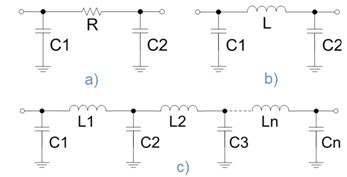
Figure 1: Schematic diagram of the common EMI/RFI filter types: a) π-type RC; b) π-type LC; c) LC trapezoid.
Among these types of EMI/RFI filters, the π-type RC filter has the widest transition band and the lowest rolloff rate from the comparison of the amplitude-frequency response; the turning rate of the π-type LC filter Lower, but the transition band is moderate; the ladder filter can achieve extremely high turning rates and narrow transition bandwidth.
In the case of EMI/RFI filtering, for mobile phone applications, a traditional reference frequency is 800 MHz because 800 MHz is close to the starting frequency of the band used by the handset. In most cases, cell phone design engineers require filtering at frequencies above 800 MHz, which typically means a minimum of 30 dB of signal attenuation. As the functionality in mobile phones increases and the clock and data signals are classified, the reference frequency is decreasing. Many portable electronics manufacturers require EMI/RFI filtering at 400 MHz, and EMI/RFI filtering at lower frequencies may be required in the future.
Integrated EMI Filtering and ESD Protection In portable products, filters are typically located adjacent to the connection port, microphone, and speaker. And these locations may also face electrostatic discharge (ESD) events. Taking an audio line as an example, if a discrete component scheme is used to separately perform EMI filtering and ESD protection, the number of components required to perform these two functions is faced. Among them, in the case of an EMI filter, if one discrete π-type LC filter is used, two surface mount capacitors and one surface mount inductor are required. In order to provide ESD protection, an additional type of surface mount transient voltage suppressor (TVS) diode is required. In this way, EMI filtering and ESD protection of one audio line requires four separate components, and there is no mention of the precious space problem of the portable devices required for these components. If there is more than one audio line, then it is even more impractical to use a discrete component solution.
Therefore, the simplest solution is to integrate EMI filtering and ESD protection in the same component. First, the integrated TVS diode in the integrated solution also provides the capacitance required for EMI filtering. Second, the improved process technology can also significantly improve the quality of the integrated inductor. By integrating these integrated components onto silicon, an integrated EMI filter + ESD protection scheme can be used (see Figure 2).
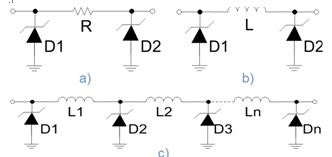
Figure 2: Integrated EMI filtering + ESD protection scheme: a) π-type RC; b) π-type LC; c) LC ladder
Among them, in terms of ESD protection level, the IEC61000-4-2 standard specifies system-level test conditions and protection levels. This level is divided into four types. Portable applications usually require level 4 protection, that is, at 8 kV contact discharge or Under the test conditions of 15 kV air discharge IEC61000-4-2, portable devices need to be able to withstand the impact of ESD events.
Overall, by cost-effectively integrating EMI filtering and ESD protection, portable application designers can reduce costs, reduce the number of bill of materials (BOM) components, and reduce board space.
EMI Filtering + ESD Protection for Specific Applications of Portable Devices In the portable device market, mobile phones occupy an important position. Naturally, many locations in mobile phones are applied to filters that integrate ESD protection. For mobile applications, the commonly used filters include LC and RC filters, as well as common mode choke EMI filters, which help reduce parasitic inductance and provide better common mode filtering. The type bandwidth spectrum of these mobile phone filters is shown in Figure 3.
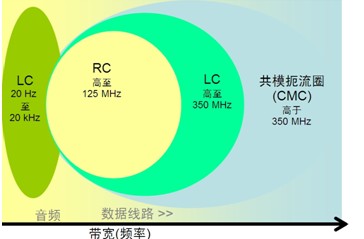
Figure 3: Cell phone filter type bandwidth spectrum.
Different mobile phone applications require different filters. In general, the higher the data rate of the application, the smaller the total capacitance of the filter line. For mobile applications such as audio lines with relatively low data rates, the standard capacitance of EMI filters is in the range of a few hundred pF, which is sufficient to provide excellent filtering performance and minimal signal interference.
Among them, in audio applications such as speakers, microphones, audio jacks/earphones, LC or RC type filters, such as ON Semiconductor's NUF2441FCT1G, NUF2450MUT1G, NUF2114MNT1G, NUF2116MNT1G, and NUF4220MNT1G, are integrated. These filters are integrated with ESD. Protection function protects 2 to 4 audio lines with diode capacitance between tens of pF and 240 pF. Taking NUF2441FC as an example, this LC filter provides EMI filtering and IEC61000-4-2 Level 4 ESD protection for two audio lines. It uses a flip-chip package to replace two inductors with a single IC. Four capacitors plus four TVS diodes help save cost and reduce board space. The NUF2450MUT1G is also a two-wire LC EMI filter and ESD protection device that provides greater than -30 dB attenuation over the 800 MHz to 5.0 GHz frequency range; this device is available in a space saving uDFN 1.2 x 1.8 x 0.5 mm ultra small package With a 20 MHz cutoff frequency and minimal line impedance, it is ideal for audio applications that require low bandpass attenuation. The NUF2114MNT1G is a two-wire RC EMI filter and ESD protection device that provides greater than -30 dB attenuation at 900 MHz to 3.0 GHz in a DFN8 package, replacing up to 10 discrete components with a single IC. Help reduce costs and save space.
In mobile applications, data lines such as displays and cameras have higher bandwidth than audio, and RC filters can be used, such as ON Semiconductor's NUF40xx, NUF60xx, and NUF80xx devices in the uDFN package. In addition, ON Semiconductor has introduced X3 series RC filters in very small WDFN/uDFN packages for data line filtering applications, including the NUF4310MN and NUF4110MN. This new family of 4-channel RC filters has a line capacitance of only 17 pF at 2.5 V and integrates 40 discrete components to provide a very small footprint (1.0 x 1.4 x 0.75 mm / 1.0 x 1.6 x 0.75 mm) Very low impedance (100 Ω) and industry leading ESD protection (IEC61000-4-2 Level 4), supporting up to 120 Mbps bandwidth, suitable for mobile phones, mobile interconnect devices (MID), portable media players (PMP), Applications such as high-resolution camera modules and displays for portable products such as digital cameras, laptops or netbooks.
High-speed LC filters, such as ON Semiconductor's NUF2900MN, can also be used in data applications such as high-resolution displays and camera interfaces. Compared to conventional RC filters, high speed LC filters have higher cutoff frequencies, greater broadband attenuation, and lower insertion loss. For example, the typical cutoff frequency of the NUF2900MN is 350 MHz, providing greater than -30 dB attenuation at 800 MHz to 6.0 GHz, and insertion loss performance is also advantageous, see Figure 4.
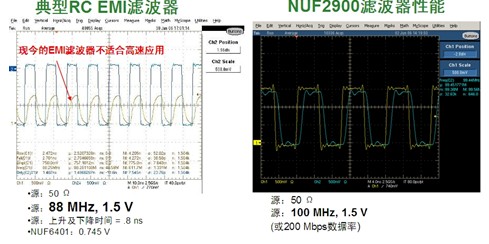
Figure 4: Comparison of the response performance of a typical RC EMI filter versus a high speed LC EMI filter (NUF2900).
It is worth mentioning that there are more and more high-bandwidth applications in mobile phones, larger display screens and higher resolution, and limited space, which drives parallel data to serial data. The solution is to use low-voltage differential signaling ( LVDS) Serial data such as MDDI, MPPI, USB 2.0 and uSerDes, correspondingly using common mode choke (CMC) EMI/RFI filters to filter out unwanted common mode EMI/RFI through high bandwidth differential signals signal. In this regard, ON Semiconductor's NUC2401MN high-speed serial data filter can be used. This is the industry's first CMC filter with integrated ultra-low capacitance (0.8 pF) ESD protection and common mode filtering. It is available in a small 2.0 x 2.2 mm DFN package with single components for USB 2.0 (480 Mbps) and IEEE 1394 (400 Mbps). High-speed designs such as MDDI (up to 550 Mbps), MIPI (up to 1.0 Gbps), and HDMI 1.2 (up to 1.32 Gbps per channel) eliminate common-mode noise for these applications and provide a clean data stream.
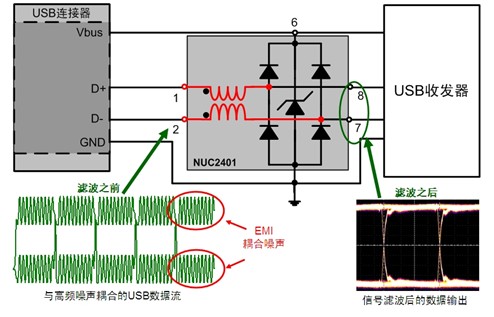
Figure 5: Integrated CMC filter with ultra-low capacitance ESD protection The NUF2401MN is used for high speed applications such as USB 2.0.
It is worth mentioning that the NUC2401MN provides superior ESD clamping performance compared to silicon competing devices with a capacitance of less than 1 pF, making it ideal for EMI filtering and ESD protection applications for high-speed data lines.
Summarizing portable devices such as mobile phones, as data rates and clock frequencies increase, high-performance EMI filtering and ESD protection schemes are increasingly needed. As the world's leading supplier of high performance, energy efficient silicon solutions, ON Semiconductor offers new integrated EMI filters that provide excellent EMI/RFI filtering performance while providing IEC61000-4-2 Level 4 compliance. The ESD protection feature replaces 10 or even dozens of discrete components with a single IC, making it ideal for audio and data line applications in portable applications such as mobile phones.
Ningbo Autrends International Trade Co.,Ltd. , https://www.vapee-cigarettes.com
